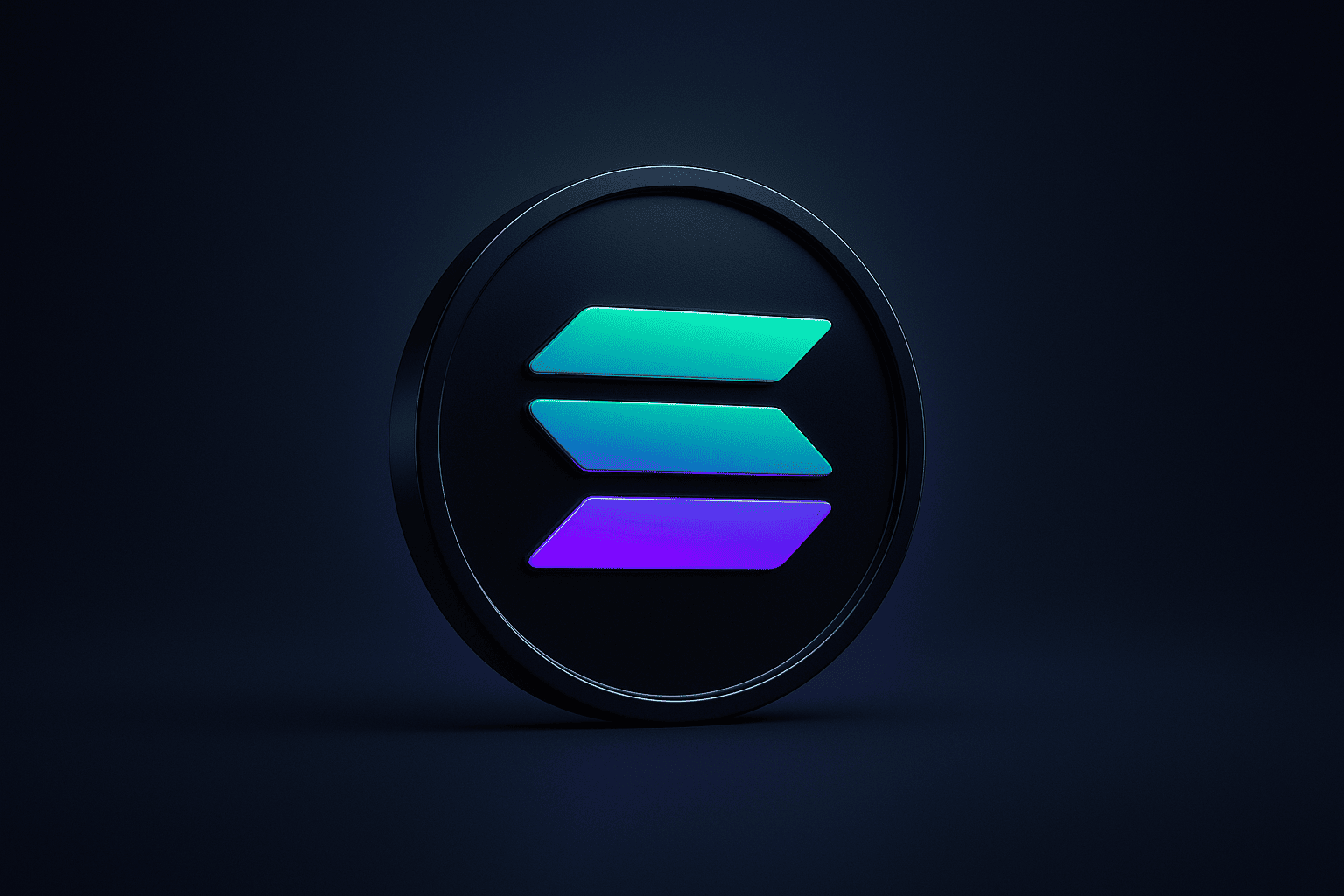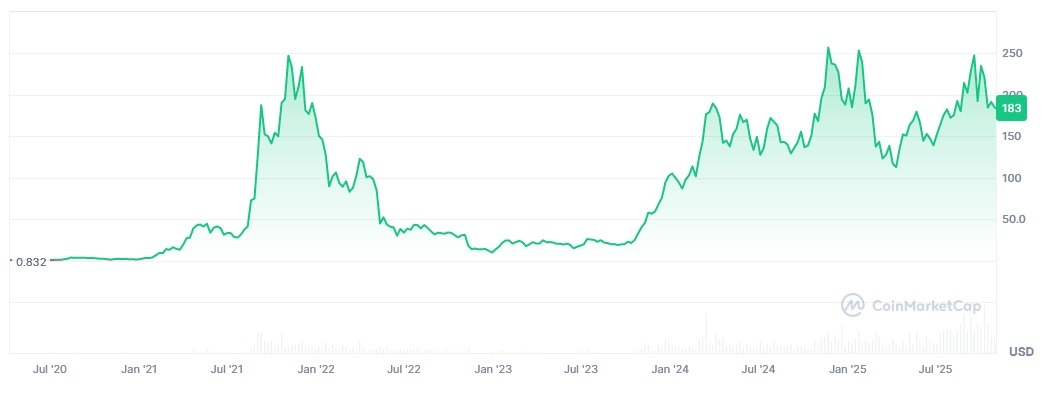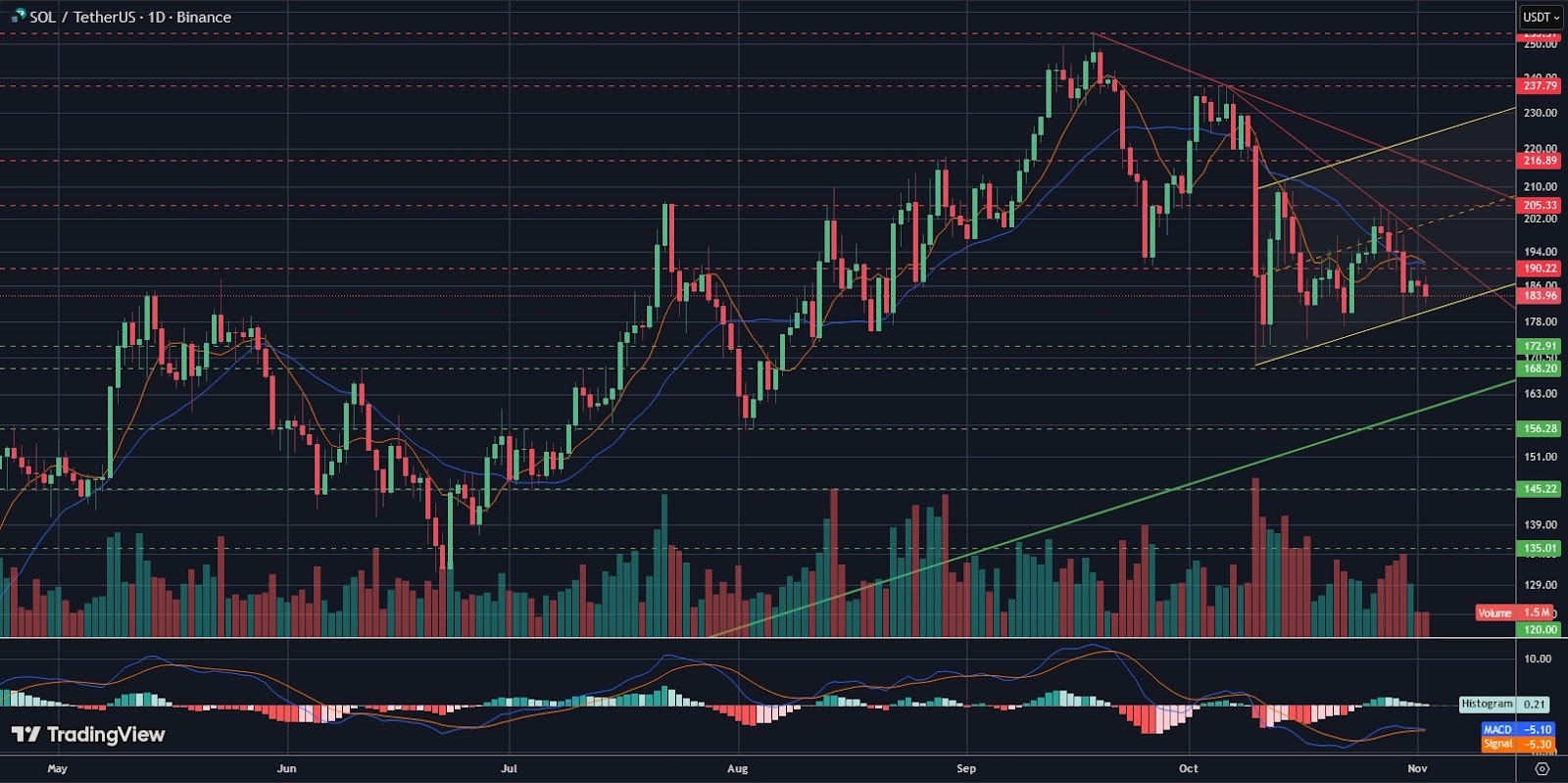Solana Price Prediction 2025-2030

Are you wondering about the future of Solana (SOL) and its price potential in the coming years? In this article, we will delve into the price predictions for Solana in 2025 and beyond.
Solana is one of the most popular blockchain platforms, offering a highly scalable and low-cost solution for decentralized applications (dApps). However, the future price of SOL token remains uncertain, driven by both technological advancements and external market forces. This article will focus on Solana and its price predictions for the coming years.
It's important to note, however, that cryptocurrency price predictions are inherently speculative and influenced by a wide range of unpredictable factors. While we draw on data and expert analysis to inform our predictions, readers should approach these forecasts with caution and conduct their own research before making any investment decisions.
What is Solana (SOL)?
Solana is a high-performance blockchain platform that aims to provide fast, secure, and scalable solutions for dApps and crypto projects.
Solana’s founders and history
Solana was founded by Anatoly Yakovenko, a former engineer at Qualcomm and Dropbox. He was inspired to create Solana after identifying scalability issues with existing blockchain platforms and seeing the need for a faster, more efficient system.
The development of Solana began in 2017. Solana Labs, the company behind the Solana blockchain, was officially founded in 2018 by Anatoly Yakovenko and entrepreneur Raj Gokal.
The Solana mainnet was launched on March 16, 2020. Since then, the platform has experienced rapid growth. By the end of 2021, Solana had gained widespread adoption in decentralized finance (DeFi), non-fungible tokens (NFTs), and various decentralized applications (dApps).
On August 3, 2022, a hack affected 9,231 Solana wallets, with four specific wallet addresses being used to steal around $8 million from victims. According to a Solana Foundation's statement, the hack happened due to a vulnerability in the digital wallet software provided by Slope Finance.
In June 2023, the U.S. Securities and Exchange Commission (SEC) filed a lawsuit against Coinbase, claiming that Solana, along with twelve other cryptocurrencies available on the platform, should be classified as securities based on the Howey Test. Solana, however, has rejected the SEC’s claim, maintaining that its token is not a security.
In 2022, Solana Labs and Jump Crypto announced Firedancer, a new independent validator client designed to increase the network’s speed, reliability, and resilience. After several years of development and public testnets, a hybrid version called Frankendancer went live on mainnet in September 2024. As of late 2025, Firedancer is being gradually adopted by validators on mainnet.
In early 2025, CME Group announced the introduction of SOL futures contracts. In October 2025, options on SOL futures also went live.
In mid-2025, R3, a UK software group that has been developing blockchains for big financial institutions, including HSBC, Bank of America, and the Monetary Authority of Singapore, reached an agreement with the Solana Foundation to utilize the Solana blockchain for asset tokenization initiatives.
Solana overview
Solana operates as a high-performance blockchain that is designed to handle large-scale dApps and transactions efficiently. The key to its functionality lies in a combination of innovative consensus mechanisms, scalable architecture, and an optimized infrastructure. Solana's performance is based on the following key innovations.
- Proof of History (PoH). Solana's unique Proof of History (PoH) is a cryptographic clock that timestamps each transaction. This ensures that all nodes in the network agree on the order of events without the need for direct communication. By using PoH, Solana reduces the time required to confirm transactions, allowing the network to process thousands of transactions per second. PoH essentially acts as a timeline that validators can follow to ensure accurate transaction ordering.
- Tower BFT. Tower BFT (Byzantine Fault Tolerance) is an algorithm Solana uses to achieve consensus. This mechanism is an optimized version of Practical Byzantine Fault Tolerance (PBFT), designed to improve transaction speeds. Tower BFT is a Proof of Stake based consensus mechanism that uses Proof of History as a clock, reducing throughput loss and data transfer latency.
- Sealevel. Solana uses a parallel processing engine called Sealevel. Unlike many blockchains that process transactions one at a time, Solana can handle multiple transactions in parallel, dramatically increasing its throughput.
- Turbine. Solana uses the Turbine protocol to break transaction data into smaller packets and send them to nodes across the network. This reduces the amount of bandwidth required to propagate data across the blockchain, enabling faster data transmission. By reducing the load on nodes, Turbine ensures that Solana remains scalable as more transactions and nodes join the network.
- Gulf Stream. Gulf Stream is Solana’s mempool-less transaction forwarding protocol. In many blockchains, transactions sit in a mempool (a waiting area) before they are processed. Solana eliminates the need for a mempool by identifying validators in advance and forwarding transactions directly to validators even before they are included in the next block.
- Pipeline. Solana uses a technique called pipelining to process streams of transaction data. This involves validating and replicating data across the blockchain nodes in an organized manner, further speeding up transaction processing. Pipelining allows various stages of transaction validation and execution to happen simultaneously, reducing delays and optimizing overall block production.
- Cloudbreak. Cloudbreak is a horizontally scaled account database that is Solana’s solution for managing the enormous amount of data generated by a high-performance blockchain. It allows the network to read and write data simultaneously across multiple nodes, which ensures that Solana can scale efficiently without data bottlenecks.
This design allows Solana to offer high transaction throughput, low fees, and quick finality, making it an attractive choice for developers building dApps and for users seeking fast, affordable transactions.
Solana (SOL) token
SOL is the native utility token of the Solana network. It is used for paying transaction fees, staking, and participating in governance decisions.
SOL initially had a total supply of 500 million tokens. Over time, this number has slightly increased due to inflation, which is designed to provide staking rewards. However, Solana incorporates a deflationary mechanism through transaction fee burning. A portion of every transaction fee paid in SOL is burned (removed from circulation), helping counterbalance inflation by reducing the total supply over time.
SOL statistics (as of 2/11/25)
| Current price | $183.92 |
| Market cap | $101.59B |
| Circulating supply | 552.49M SOL |
| Total supply | 613.12M SOL |
| Daily trading volume | $3.05B |
| All-time high | $294.33 (19/01/25) |
| All-time low | $0.5052 (11/05/20) |
Advantages and disadvantages of Solana
Like any investment asset, Solana comes with both strengths and challenges. Let's explore its key advantages and disadvantages.
Key advantages of Solana
- High transaction speed. Solana’s blockchain is designed to process transactions at a much faster rate than many other platforms, with the capability to handle up to 65,000 transactions per second (TPS).
- Low transaction costs. The network’s architecture allows for very low transaction fees, often less than $0.01 per transaction. This makes Solana an attractive option for dApps, decentralized finance (DeFi) platforms, and NFT projects, where high fees on other platforms, such as Ethereum, can be prohibitive.
- Scalability. Unlike many other blockchains that face scalability issues as they grow, Solana can scale without the need for layer-2 solutions or sharding. Its architecture is built to maintain efficiency as the number of users and applications increases, ensuring that transaction speeds and costs remain consistent.
- Growing ecosystem. Solana has developed a robust and expanding ecosystem, with numerous DeFi platforms, NFT marketplaces, and Web3 projects built on its network.
- Developer-friendly. Solana provides a robust infrastructure for developers, with grant programs, comprehensive documentation, and numerous educational initiatives.
- Balancing of inflation. Although the total supply of SOL tokens is gradually increasing due to staking rewards, this is balanced by the mechanism of transaction fee burning.
Key disadvantages of Solana
- Network instability and outages. Despite its impressive speed and scalability, Solana has experienced several network outages and downtimes, which have raised concerns about its reliability. For example, in 2021 and 2022, the network suffered several outages due to high traffic volumes and bugs in its system, causing disruptions to transactions and applications.
- Security risks. Solana has faced security challenges, including a notable hack in August 2022, where over 9,000 wallets were compromised, and about $8 million in assets were stolen. The hack was traced back to a vulnerability in third-party wallet software, not the core Solana network, but it has raised concerns about the platform's security.
- Centralization concerns. Despite the decentralized nature of the platform, Solana has faced criticism over centralization risks, particularly regarding the concentration of validator power among a small number of entities.
- Regulatory uncertainty. Like all cryptocurrencies, Solana operates in a largely unregulated space, making it vulnerable to sudden regulatory changes that could impact its growth and operations.
- Competition. Solana faces strong competition from both established players like Ethereum and newer blockchains such as Avalanche and Toncoin, each with its own set of advantages and growing ecosystems.
Solana (SOL) price history
SOL entered the market in April 2020, trading at around $0.50-$0.90. In July 2020, the token price surpassed $1.00. In early 2021, the price of Solana gained momentum as the broader crypto market surged. As early as February 2021, the price of SOL exceeded $10, and on November 6 it reached its all-time high.
After reaching its peak, Solana began to fall amid the general decline of the crypto market. At the beginning of 2023 the decline stopped and the price started moving sideways, which lasted until October 2023. The rapid growth of SOL, which happened after that, lasted until April 2024 and was followed by a smooth correction in a wide range.
The sharp growth of the crypto market in November 2024 impacted SOL as well, and on January 19, 2025 the price of the token reached a new all-time high. After that, a severe price correction began, which lasted until early April.
In April 2025, the price began to recover, which, despite occasional pullbacks, continued until September 19. Then, failing to reach its all-time high, the price started falling again, showing high volatility.

Solana price predictions
Solana (SOL) technical analysis
After a sharp drop in prices on October 10, SOL is moving in a broad upward channel. Moving Averages and MACD indicate neutral sentiment. Parabolic SAR and RSI, however, are bearish. The daily trading volume is $3.05B which is 7.73% more than the previous day.
The nearest support levels are $173.00, $168.00 and $156.00. The nearest resistance levels are $190.00, $205.00 and $217.00.

Short-term SOL price prediction
The most likely scenario at the moment is a further price decline to the support level of $173 and possibly lower. However, in case of positive developments in the broader crypto market, a breakout of the diagonal resistance line and growth to the resistance level of $205 and above cannot be ruled out.
Medium-term SOL price prediction 2025
After a strong recovery through 2024 and high volatility of 2025, SOL’s next move will largely depend on the interplay of network fundamentals, institutional participation, and broader macroeconomic dynamics.
In the base scenario, Solana is in a moderate uptrend. Network usage continues to expand and institutional interest grows at a steady pace. In this environment, SOL can trade in the $150 to $300 range.
An optimistic scenario can unfold if macroeconomic conditions become more favorable for risk assets. Broader crypto market growth, combined with strong inflows into Solana-based projects as well as institutional interest, can push SOL higher into the $300-$400 range.
Conversely, a bearish scenario might emerge if investor sentiment deteriorates or the network faces fresh technical setbacks. Regulatory pressure, a period of network instability, or the beginning of a new “crypto winter” can cause a pullback, bringing the price of SOL back into the $60 to $150 range.
Long-term SOL price prediction 2026-2030
The Solana blockchain has a number of technical advantages that make it promising. However, it should be taken into account that it has serious competitors who are not sitting idly by. If the project keeps developing successfully, we may well see a significant increase in the price of its token.
High price scenario
In this scenario, Solana becomes the leading platform for dApps, DeFi, and NFTs. Its ecosystem sees massive growth, with thousands of projects relying on Solana’s low fees and fast transaction speeds. Solana's robust infrastructure and scalability make it a go-to solution for large enterprises and financial institutions looking to integrate blockchain technology into their operations. In this high price scenario, the SOL token can potentially reach a price range of $500 to $1,500 by 2030.
Moderate price scenario
In a moderate price scenario, Solana's ecosystem continues to expand, with more developers building on the platform. However, it faces significant competition from both well-established blockchains like Ethereum and Binance Smart Chain, and newer entrants like Avalanche. At the same time, Solana addresses its past network outages and improves reliability, making it a more attractive choice for developers and users. In this scenario, SOL's price can range from $200 to $500 by 2030.
Low price scenario
In the low price scenario, Solana faces significant challenges that limit its growth potential. It struggles with network outages or faces major security vulnerabilities that reduce its reliability and reputation. Other blockchains, such as Ethereum or emerging technologies, outperform Solana in terms of scalability, decentralization, or developer engagement, causing Solana to lose market share. Stricter regulatory measures or government actions negatively affect Solana and the broader crypto market, limiting its growth potential. In this pessimistic scenario, SOL's price could fall below $30 by 2030, with potential for stagnation or further decline due to technical, competitive, or regulatory challenges.
faq quetstion
.svg)
Will Solana reach $1000?
According to many experts, under favorable developments, this is quite within the realm of possibility.
Is Solana (SOL) a good investment?
Solana can be a strong investment due to its technological advantages, growing ecosystem, and potential for broader adoption in DeFi, NFTs, and Web3 applications. If the network continues to improve in terms of reliability and scalability, and if it maintains its competitive edge, SOL can see significant price growth over time.
However, it should be remembered that investing is always risky, especially investing in cryptocurrencies. Before making investment decisions, always do your own research and make sure that you are not investing more than you can afford to lose.
How to buy Solana?
Solana is one of the largest cryptocurrencies by market cap. It can be bought on many crypto exchanges. On the YouHodler platform, you can exchange other cryptocurrencies for Solana, as well as buy it with a credit card or your SEPA bank account.
Suggested Posts



YouHodler is regulated in Switzerland, the EU and Argentina.
YouHodler SA
Registered financial intermediary
YouHodler Italy S.R.L.
VASP registered at OAM / MICAR
YouHodler SA
Registered as VASP with Banco de España
YouHodler SA Branch in Argentina.
Registered as a VASP with the CNV.








